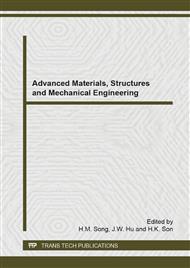p.32
p.37
p.42
p.46
p.50
p.56
p.60
p.64
p.68
Modelling of Fretting Wear under Partial Slip Conditions Using Combined Isotropic-Kinematic Hardening Plasticity Model
Abstract:
This paper presents finite element modelling of fretting wear under partial slip conditions using combined isotropic-kinematic hardening plasticity model with the emphasized to investigate the cyclic-plasticity behaviour predicted under fretting condition. The model is based on two-dimensional (2D) cylinder-on-flat contact configuration of titanium alloy, Ti-6Al-4V. A number of wear profiles at specific number of wear cycle (6000th, 60000th, 150000th and 300000th) are simulated. Contact pressure, tangential stress, shear stress, equivalent plastic strain, tangential plastic strain and also shear plastic strain are gathered and analysed. It is found that the plastic strain response of the combined isotropic-kinematic hardening plasticity model is slightly higher compare to linear kinematic hardening plasticity model [1].
Info:
Periodical:
Pages:
50-55
Citation:
Online since:
September 2014
Authors:
Keywords:
Price:
Сopyright:
© 2014 Trans Tech Publications Ltd. All Rights Reserved
Share:
Citation:


